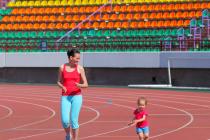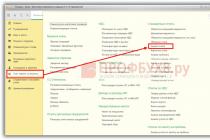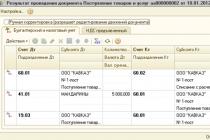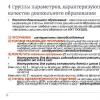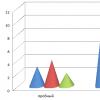What to feed pregnant (pregnant) rabbits. A lot depends on the correct feeding of pregnant rabbits: the health of the rabbits, the number of rabbits, proper development, good immunity in the young, the amount of milk in the rabbit.
After mating, the breeding males can be switched back to the diet for resting rabbits.
Diets of pregnant rabbits the total nutritional value is increased to 220 g of feed units, while per 100 g of feed units there should be 15-16 g of digestible protein.
The diet of pregnant rabbits should include feed rich in complete protein, minerals and vitamins. In the first half of pregnancy, the rabbit’s body spends a lot of nutrients on the formation of the membranes, placenta, and the embryo itself, which weighs approximately 3 g. The embryos reach their maximum development in the second half of pregnancy. The placenta continues to grow and the mammary glands enlarge. Proper feeding during this period has a beneficial effect on the fertility of female rabbits and the live weight of female rabbits at birth. It is important that the diets are not too voluminous. 5-7 days before calving, the amount of roughage and grass must be reduced, and silage feed should be completely excluded from the diet, accordingly increasing the amount of concentrates.
Of these, rabbits are given: compound feed, oats, legume grains (80-100 g), from high-protein feeds - sunflower cake (30-50 g), soybean meal (20-30 g); from juicy ones - carrots; from minerals - chalk, meat and bone meal (1-2 g), table salt (1.5 g), powdered eggshells (1-2 g), from vitamins - fish oil (2 g). The diets of young full-grown rabbits increase their overall nutritional value by 15-20% compared to the diets of full-aged animals, since their body also continues to develop.
In the second half of pregnancy, rabbits can be fed mash with approximately the following ratio: 45% concentrated feed (wheat bran - 12%, barley or oats - 23%, corn - 10%), 43% alfalfa hay, 10% meadow hay and 2% mineral supplements. Give 140-150 g of the mixture per day. Additionally, a small amount of good-quality hay and twig food are included. Including roughage in the diet increases the amount of crude fiber, which facilitates the normal functioning of the digestive system to avoid intestinal upset.
Obesity of rabbits during this period is not allowed , so they give birth to fewer rabbits and the litter as a whole is often not viable. If there is a lack of mineral food during pregnancy, female rabbits eat their offspring when they are born. At this time, it is advisable to give vitamins.
In the last two weeks before giving birth The rabbit's appetite may noticeably increase. Make sure that there is always enough fresh food in the cage, and do not forget that a pregnant rabbit needs a lot of water.
Rabbit breeders practicing compacted litters (combining pregnancy of rabbits with lactation), they should increase the diets of pregnant rabbits in terms of total nutritional value to approximately 330-360 g of feed units, and per 100 g of feed units the content of digestible protein should be 16-19 g.
Carrying rabbits and their birth is a very important period, during which the female rabbit needs special attentive care: living conditions, nutrition, etc. Every rabbit breeder should know everything about the female rabbit’s diet during pregnancy, as well as what to feed the female rabbit after giving birth.

The diet of a female rabbit during pregnancy
A healthy brood can only be produced by a healthy individual that has been provided with the necessary nutrients. The diet for a pregnant rabbit should be made taking into account the fact that not only the expectant mother needs more vitamins, macro and microelements, but also the embryos inside her.
Signs of pregnancy in "eared cats"
Six months for giant breeds and five months for large and medium-sized rabbits is considered an acceptable age for procreation. Gestation lasts an average of 30 days, it all depends on the number of rabbits.
Everyone understands that the animal will not tell you about its “interesting situation”, so you should be very observant to determine pregnancy. This must be especially monitored after deliberate mating. It may not be possible to do without consulting a veterinarian.
Female rabbits most often become shy and nervous after fertilization. They can even have miscarriages if you scare them too much. Also, the female will begin to fight off the male and hide in the corners of the cage if you try to bring them together.
By 12 days after mating, with a careful examination of the abdomen, embryos can already be felt; they are the size of a grape, and by 21 days, movements in the abdomen are observed.
Nutrition of a pregnant rabbit
After mating or pregnancy is determined, females are switched to more nutritious food. On average, food is given 220 grams more, while for every 100 grams of food, 15 is digestible protein. There should be a lot of clean and fresh water in the drinking bowl.
A week before the expected birth, silage feed is stopped, and grass and roughage are removed from the diet as much as possible. Instead, they add more concentrated feed: legumes, grain, oats - up to 100 g, soybean meal - up to 30 g, sunflower cake - up to 50 g, meat and bone meal, carrots, celery, potatoes (boiled). Substances needed by the expectant mother are 1.5 grams of table salt, 2 grams of ground eggshells, 2 grams of fish oil, chalk.
You also need to know what to feed the rabbit before giving birth if she is still young. The main nuance is that such organisms continue to develop themselves along with the young inside them. Therefore, the amount of their food increases by 20 percent compared to adults.
Also, if a new pregnancy and breastfeeding of the previous litter are combined, an average of 350 grams of food is added to the total amount of food and 18 grams of digestible protein is added for every 100 grams.
Sample menu for a rabbit before giving birth
Feeding during the second half of pregnancy looks something like this:
- 2% mineral supplements;
- 10% meadow grass;
- 43% hay;
- 45% grain feed.
Tree branches are also given, which improves food digestion processes.
It is important to know that overfeeding a pregnant rabbit is just as harmful as underfeeding it. Excess weight in an animal is dangerous because the offspring will not be viable.
The diet of a female rabbit after giving birth
It is very important to pay attention to feeding the female rabbit after giving birth, since during this period the female’s body must recover itself and also be able to fully produce breast milk for the rabbits.
Rabbit birth most often occurs at night or early in the morning and lasts about a quarter of an hour. When the rabbit gives birth, you need to place a large bowl of water in front of her, as she will be very thirsty.
Lactation in long-eared mothers begins after childbirth. In order for the female to produce milk, it is necessary to feed her with herbs: alfalfa, clover, plantain, dandelions, vegetable tops, etc.; vegetables and fruits: potatoes, fodder beets, carrots, apples.
Make the so-called mash, i.e. combined mixtures of mineral supplements, hay, bran, oats.
The food contains almost the same additives as during pregnancy: chalk, fish oil, salt, meat and bone meal.
The amount of food after birth does not decrease, especially since after 20 days the baby rabbits will also begin to eat from their mother’s bowl, then powdered milk is added to the food. The average daily food requirement for a postpartum rabbit weighing 5 kg is:
- 1st – 10th day of lactation – 330 grams of feed;
- before 20 days – 440;
- before 30 days – 560;
- before weaning rabbits - 700.
Approximately 100-300 g is hay, 30 g is sunflower meal, 50-60 g is sunflower cake, 5 g is feed yeast, the rest is fish oil, chalk and other additives. At the same time, for every 100 grams of food, 18 are protein.
Menu for increasing lactation in rabbits
The absence of milk or its deficiency may depend on various reasons: the age of the female, the number of litters, nutrition. Most often the problem is in nutrition. On average, a “young mother” produces up to 200 grams of milk, while about 0.9 grams of consumed feed is spent on the production of each gram.
A female that has hatched needs to be fed very well, we have already found out: succulent and green food, vitamins and minerals. But what to do if there is no lactation or it needs to be strengthened?
First, be sure to stock up on mash of barley, alfalfa and oats or corn and wheat bran; secondly, give herbs that stimulate lactation: parsley, dill, elecampane. Just be careful with milk-producing plants - the essential substances in them can destroy the female and her offspring, so they are placed in the feeder in doses. Silage and various root vegetables also help.
What to feed rabbits in winter, female rabbits after giving birth and small rabbits
Fostering rabbits. What to feed
How to care for small rabbits and a female rabbit after giving birth
By the way, there is no need to feed rabbits with fresh milk to increase their production; this can cause them to develop gases.
Drugs
Sometimes, to initiate lactation, they resort to the help of pharmaceutical drugs. For example, they inject oxytocin, thanks to which milk may appear in the breast within 24 hours.
If all else fails, you will have to place the newborn rabbits with other nursing rabbits or start feeding them yourself.
Features of feeding newborn rabbits in winter
Of course, in the summer, feeding rabbits after giving birth is not as expensive and difficult as in the winter, because various herbs, vegetables, grain shoots, etc. are freely available. But this does not mean at all that the rabbit’s diet may be poorer in winter. It is necessary to look for a full-fledged replacement, which would also ensure the supply of vitamins and valuable substances to the body of the “young mother”.
Winter feeding of a pregnant female
In winter, before giving birth, a rabbit’s daily menu may include the following food: 200 grams of hay, 150 grams of boiled potatoes, 100 grams of carrots, 80 grams of cereal grains or feed, 10 grams of cake, 15 grams of wheat bran.
In pet stores it is worth purchasing special vitamin supplements for rabbits to compensate for the animal’s lack of nutrients. In winter, you can also give more feed - up to 100 grams per day, germinate grains of oats, wheat, etc.
What to feed after giving birth in winter?
You can feed a young female in winter with the following products: boiled potatoes, high-quality silage, bran, oil cake, herbs from nettle, wormwood, etc., stored over the summer. By the way, it is better not to get carried away with legumes; they can make the female very swollen.
Per day, the animal will need: 200 grams of boiled potatoes, 40 grams of bran (wheat), 30 grams of meal (cake), 70 grams of grain.
Organizing proper nutrition for a nursing rabbit is no less important than taking care of the offspring that are born. The animal spends all its strength and energy on feeding its cubs; the quality and quantity of milk, and therefore their health, growth and development, will depend on the nutritional value and balance of the food received.
Nutrition of a pregnant rabbit before giving birth
A pregnant rabbit must be provided with all the nutrients in the required quantities. This is the key to a successful pregnancy and the birth of healthy babies.
Main components of the diet
Pregnant rabbits need to be fed more nutritious food, increasing its volume by 220 g.
- Protein-rich foods: oats, legumes, sunflower cake (it contains a lot of essential proteins), mixed feed.
- Vegetables (or raw carrots). In winter they offer hay, in summer - green grass.
- Fish oil (contains beneficial omega-3 acids).
- Eggshell (powder).
- Vitamin complexes in the winter season, in summer and spring they are replaced by fruits, vegetables, and herbs.
- Mineral supplements.

Before giving birth, you need to feed the female rabbit by slightly reducing the volume of the diet, removing bulky types of food - roughage, silage, replacing it. The animal’s “menu” should include vitamin supplements, greens based on meadow grass (no more than 10% of the total), grain mixture, dried grass, and you can give pea tops.
A pregnant rabbit must be provided with clean drinking water around the clock.
Feeding the female after childbirth and the lactation period
The animal’s body simultaneously recovers after bearing offspring, and feeding begins. It is also possible that a new pregnancy may occur. Therefore, the animal’s diet must be complete and rich in essential elements.
After giving birth, the female must be given water to drink. To increase milk, which begins to arrive almost immediately, the animal is given herbs (clover, spurge, alfalfa), vegetables and tops.
Composition of a nursing rabbit's diet

The more often an animal eats, the better. It is recommended to feed the female rabbit after giving birth, depending on the time of year. If the birth occurred in the summer, preference is given to green feed (mixtures of oats, forbs, alfalfa, clover, legumes, corn). In winter, the diet is based on good quality hay, boiled potatoes and root vegetables, legumes, bran, and silage. From dry food, it is better to choose cake (sunflower or soybean), oats and peas, as they are rich in protein. The additives used are those that were used during the gestation period.
In any season, the animal is fed concentrated feed. Concentrates - mixtures of cake, bran, oats. They are digested almost completely. In order to have more milk, it also makes sense to switch to special ready-made foods that improve lactation,
Another option is mash, which is prepared from crushed products. A nursing rabbit can be treated to the following types:
- Alfalfa and crushed oats (in a ratio of 60 to 40).
- Alfalfa, barley and corn (60:30:10).
- Alfalfa, bran, legumes, wheat (60:10:10:10:10).
Vitamin and mineral complexes are added to such mixtures. You can offer the female diluted powdered or sour milk: fresh milk is not allowed, as it can upset the animal’s digestion. Mixers are used warm and wet; for this purpose, the grain is soaked in water. This food combines both food and drink, has a beneficial effect on lactation, normalizes digestive processes and is especially useful in winter.
Daily ration
- Summer: 1 kg of green grass; winter: 100–300 g of grass and legume hay.
- Legumes, mixed feed – 70–80 g.
- Sunflower cake – 40–60 g.
- Wheat bran – 30 g.
- Feed yeast – 5 g.
- Flour (fish or meat and bone) – 3–7 g.
- Table salt – 2.5 g.
- Chalk – 3 g.
15–20 days will pass after birth, and the rabbits will learn to eat on their own. Therefore, the amount of food for the family will need to be increased 3 times. Month-old babies can be fed with steamed crushed grain, good quality hay, carrots and carrot tops.
How to improve lactation

The long-eared mother is offered the following food after giving birth so that there is milk:
- White cabbage leaves.
- Root vegetables (carrots, rutabaga) and their tops.
- Silage.
- Rowan berries.
- In winter - dry alfalfa.
To increase the female's milk supply, it is important to constantly replenish the large fluid intake with food and drink. In the summer, juicy products will cope well with this task: melons,. They help increase milk production in a rabbit, but they must be given with caution and little by little: they contain essential oils, which in high concentrations can cause harm to animals.

- If the female rabbit is thirsty or her food is low in vitamins and minerals, the animal may become aggressive and eat the babies. Therefore, it is important to give the female a drink immediately after giving birth and make sure that water is available to her, as well as establish adequate nutrition.
- It happens that there is not enough milk. Then the rabbits can be given to be raised by a female who has no problems with lactation. Newborns need to be placed between the cubs of their eared mother so that they acquire the same smell, and left for a while.
In winter and summer, you need to monitor the quality of the rabbit’s diet. This will determine whether her babies will be viable. In turn, you can get a good offspring from healthy offspring. Therefore, it is imperative to know what to feed the rabbit after giving birth.
 A nursing rabbit needs enriched nutrition and a lot of water. The milk that she produces per day must contain vitamins and must - protein, of which up to 20 grams should be produced during the day. Nutrient fluid is the only nutrition for babies in winter and summer until 2 weeks of life, and additionally when the rabbits, in addition to milk, begin to eat food given to their mother.
A nursing rabbit needs enriched nutrition and a lot of water. The milk that she produces per day must contain vitamins and must - protein, of which up to 20 grams should be produced during the day. Nutrient fluid is the only nutrition for babies in winter and summer until 2 weeks of life, and additionally when the rabbits, in addition to milk, begin to eat food given to their mother.
The rabbit should receive a sufficient amount of protein food. These are peas, beans, soft corn grains (pre-soaked for 2-3 days), crushed mash with the addition of grated vegetables, etc. The mother receives the required amount of vitamins from succulent feed: carrots, beets, young fragrant grass, etc. .
The mother must change her water several times a day, both in winter and in summer, and the container must not be allowed to be empty. Along with milk, the rabbit loses a large amount of fluid. To make up for it, the mother drinks a lot of water - 2-3 times more than during normal periods.
What to feed?
How many times a day should there be meals? The more often the better. Eating should occur at the same time. The choice of feed directly depends on the time of year.
Summer period
In summer, the nutrition problem is much easier to solve than in winter, because nature is generous with root vegetables, fragrant herbs, young grain shoots, etc. The basis of the diet of a nursing rabbit at this time is alfalfa, meadow grass, oats, clover, cabbage leaves, Jerusalem artichoke, etc. You can give vegetables or vegetable tops, and green peas, beans, corn, etc. are welcome as protein foods.
Food in winter
 During this period, green juicy shoots of green plants are replaced by boiled potatoes and legume hay; forbs, which contain nettle, clover, wormwood and other beneficial herbs; roots; cake and bran, which are a source of healthy fiber that improves the digestion process; mineral supplements (for example, chalk, which replenishes calcium deficiency in the rabbit’s body).
During this period, green juicy shoots of green plants are replaced by boiled potatoes and legume hay; forbs, which contain nettle, clover, wormwood and other beneficial herbs; roots; cake and bran, which are a source of healthy fiber that improves the digestion process; mineral supplements (for example, chalk, which replenishes calcium deficiency in the rabbit’s body).
Concentrates
The female rabbit loses a large amount of energy during the period of feeding her rabbits, especially in winter. So that she does not lose weight and continues to remain energetic, and her body has enough substances to produce full-fledged milk, the daily norm of concentrates in her menu increases - up to 80%. These can be mixtures purchased at pet stores, bran, cake, oat mixture, crushed vegetables, etc.
Watch a video on what else you can feed your rabbit for best results.
Daily ration
 The issue of forming the daily diet of an eared mother should be approached with all seriousness - both her health condition and the growth indicators of the babies depend on this. How much food should she be given? The composition of the following sample menu indicates the proportion of feed:
The issue of forming the daily diet of an eared mother should be approached with all seriousness - both her health condition and the growth indicators of the babies depend on this. How much food should she be given? The composition of the following sample menu indicates the proportion of feed:
- The amount of fresh aromatic herbs should reach up to 300 g per day.
- Sunflower cake can be increased to 40-60 g.
- The amount of sunflower meal is approximately 30 g.
- Feeding yeast would be useful - about 5 grams.
- The source of vitamins A and E is fish oil - 4 grams is enough.
- To maintain healthy bones and the full formation of the skeleton of a baby rabbit, the mother should be given meat and bone meal -7 grams in winter and summer, bone meal and chalk - 3 grams each.
- The salt a rabbit needs is 2.5 g.
Mash
In autumn and winter, mash helps to compensate for the deficiency of many vital substances in the rabbit’s body. It is desirable that the diet of a nursing rabbit should contain up to 60% of oats or a mixture based on it, and up to 40% of alfalfa; Mineral supplements will also come in handy.
The mash may include:
- up to 10% flour made from alfalfa;
- up to 10% legumes;
- about 12% bran;
- mineral supplements.
The number of servings directly depends on the mother’s fatness and the number of rabbits. It is clear that the more babies suck milk, the sooner the rabbit’s body must make up for its deficiency. By 2-2.5 weeks, the rabbits learn from their mother to eat from the feeder, so the amount of food needs to be increased 3 times. You can add a little sour or powdered milk to the mash - this will only improve its nutritional value.
Features of feeding rabbits
Special attention should be paid to these points.
 If there is not enough milk
If there is not enough milk
Newborn rabbits require up to 5 ml. milk a day. If the babies are applied to the female 5 times a day, it turns out that they should eat 1 ml in 1 approach. nutrient fluid. How much milk does a female rabbit produce? The female produces from 50 to 270 grams. milk per day. It is necessary to ensure that babies eat mother’s milk at least 2-3 times a day, especially in the first 2 decades of lactation, when milk production reaches up to 61% of the total milk volume during the lactation period.
How can you tell if babies don't have enough milk? They are lethargic, exhausted, squeak loudly, and the skin on their tummies wrinkles. Well-fed baby rabbits are immediately visible: their tummies are puffed up, their skin is straightened, they quickly become covered with their first fur.
In order to increase the amount of milk produced per day in winter and summer, the rabbit should be given more protein and vitamin food so that there is “fuel” to convert it into milk. Dill, parsley and elecampane have excellent milk-producing properties. They can be added to mash.
Feeding problems and their solutions
A female rabbit who sits aside from her newborn babies and stubbornly ignores them may do this for the following reasons:
- A hormonal imbalance has occurred (in this case, experienced breeders advise pairing a female with a male - the hormonal level returns to normal and the female calms down.
- Experienced stress, fear, feeling of threat (this happens when the female’s peace is constantly disturbed, the rabbits are taken out, the cage is often cleaned, etc.);
- The first-born female may refuse to feed the cubs due to the lack of maternal instinct.
To solve the problem in the latter case, you need to move the rabbit to a warm place and create comfortable conditions for feeding, turn her on her back so that there is no interference for the babies and place them one by one on the nipples.
Particular attention should be paid to whether lactation is successful. You can verify this by lightly pressing each nipple. A small drop of milk should come out. If problems occur in the body, the female looks thin, the skin on her abdomen is wrinkled, her behavior is sluggish and indifferent, or, on the contrary, very aggressive.
- If you do not take care of the water container and allow it to remain empty, the female may eat the newborn rabbits.
- She does not disdain her own cubs (no matter how many there are) even when there are few mineral supplements and vitamins in the food.
- In order for the mother to feel comfortable while feeding the babies, she should build a comfortable bed (especially in winter) based on the principle of a mink and protecting the walls from drafts.
It also happens that orphaned rabbits need to be “placed” with another rabbit. Or one eared mother does not have enough milk, while the other has too much milk. Strangers should be placed in the center, covered with the down that covers other rabbits and left for several hours. During this time, their bodies will acquire the same smell as their eared relatives.
Igor Nikolaev
Reading time: 5 minutes
A A
The diet of pregnant and lactating rabbits must be given special attention, since during these periods they eat not only to meet the needs of their body, but also to ensure the normal development and growth of the offspring. During gestation, a lot of energy is spent on the formation and development of embryos, and during feeding - on milk production. What to feed a female rabbit after giving birth, as well as the peculiarities of her feeding during pregnancy is the topic of our article.
The diet of a female bearing offspring must contain at least 220 feed units (FU). During this period, products with a high protein content are added to it at the rate of every 100 KE - approximately 10-15 grams of proteins.
These proteins are best absorbed by the animal's body. They are mainly spent on the formation of the placenta, amniotic membranes and the embryos themselves, so that the expectant mother herself has only a small amount left to ensure her own vital functions.
In addition to proteins, the diet of a pregnant female should contain vitamins and minerals in the quantities required by the mother and offspring. The diet of a female rabbit in the second half of pregnancy is characterized by a sharp reduction in the proportion of bulk feed. Silage is completely excluded from the diet and, as a rule, it is replaced with carrots.
What foods are most beneficial and nutritious for pregnant females?
- Legume grains (for example, beans or peas), oats and mixed feed - at the rate of approximately 80 grams in summer and up to 100 in winter in summer and 100 in winter (the share of legume types of feed should be at the level of 25 percent of the total amount of dry food);
- sunflower cake containing a large amount of proteins - ranging from 30 to 50 grams;
- soybean meal - from 20 to 30 grams;
- boiled potatoes – 100 grams;
- carrots – about 150 grams;
- in winter – fresh high-quality hay – approximately 150-200 grams; in summer - green grass feed from 550 to 700 grams;
- meat and bone or fish meal and chalk - approximately one to two grams;
- table salt – 1.5 g;
- ground eggshells into powder - one or two grams;
- fish oil - two grams.
The winter diet of a pregnant female must contain vitamin complexes designed to compensate for the lack of green food at this time, which serves as a source of vitamins in the summer. It is useful to introduce sprouted grains – oats or wheat – into the rabbit’s diet. It is also necessary to give her mineral supplements (usually they come in combination with vitamin supplements). If there is an acute deficiency of salts and minerals in the female’s body, she is able to eat the newborn offspring.
The total volume of the diet of young rabbits during pregnancy increases by approximately 15 to 20 percent of the usual, since the expectant mothers themselves are still growing.
However, pregnant females should never be overfed. If they develop obesity, the offspring will be weak and not viable.
Immediately before giving birth (about a week before the expected due date), the amount of feed should be slightly reduced, mainly due to bulk types. Green plant foods should be high in protein (alfalfa is good). Pea tops are also well absorbed by the pregnant rabbit's body. The share of meadow grasses in the total diet should be no more than 10 percent of the total amount of green food.
Particular attention should be paid to ensuring that the female has 24-hour free access to clean and fresh water.
Before the female starts giving birth, check the drinking bowl. If there was no water in the cage at the time of giving birth, the female rabbit may eat the cubs.
A lactating female also spends a lot of nutrients, minerals and vitamins on producing milk to feed her offspring. In this regard, during this period it is necessary to provide it with a sufficient amount of all the substances listed above. In addition, the dairy rabbit needs a large volume of fluid, which is constantly consumed to produce milk.
The amount of food products is determined based on the age of the growing cubs.
Typically, in the first ten days of feeding, the daily ration should be at the level of 330 feed units. Starting from the eleventh and up to the twentieth day of life of the rabbits, this figure increases to the figure of 440-k. Well, if the cubs are from 20 to 30 days old, then during this period the female should receive food daily in the amount of 560 food units.
If the rabbits are not weaned within a month and they remain suckled, then from the thirtieth day until the end of milk feeding the female rabbit needs 700 KE per day. In the daily diet, for every 100 units of food there should be at least 16 - 18 grams of protein, since to produce one milliliter of milk a rabbit needs to spend about 0.9 grams of protein. In other words, every day this number can reach almost thirty.
If the birth occurred in the summer, the basis of the diet should be green plant foods. Preferred foods are clover, dry alfalfa, meadow herbs, and oat mixtures.
In winter, most of the diet consists of high-quality forb hay, legumes, boiled potatoes and other root crops, as well as high-quality silage. Of the dry types of food, sunflower or soybean cake, peas and oats are preferable, since these products contain the most protein.
An approximate daily menu for a female after giving birth and during lactation looks like this:
- forb and legume hay - from one hundred to three hundred grams (in the summer, one kilogram of green grass is given instead);
- sunflower cake – approximately 40-60 grams;
- sunflower meal or wheat bran – approximately 30 grams;
- legumes and mixed feed - from 70 to 80 grams;
- special feed yeast - approximately 5 grams;
- meat and bone or fish meal - three to seven grams;
- fish oil – 3-4 g;
- chalk - about three grams;
- regular table salt - two and a half grams.
When they reach twenty days of age, the cubs begin to emerge from the nest. From this moment on, they gradually begin to be accustomed to “adult” food.
Starting from the age of one month, the young animals are fed with crushed grain, which is recommended to be pre-steamed in boiling water, then cooled and given to the rabbits. Also, suckling young animals can be fed with carrots, as well as their tops and high-quality hay.
To increase the female's milk production, it is good to use green food, silage and various root vegetables. In winter, it is necessary to increase the proportion of succulent feed (silage and vegetables) in the diet. Experts also recommend giving a nursing rabbit sprouts of parsley and dill, which have a beneficial effect on milk production. However, these herbs must be dosed very carefully. Parsley and dill contain a large amount of essential oils, and their high concentration in the body can kill both the baby rabbit and the mother herself.
Experienced rabbit breeders advise giving lactating females a mash of, for example, 60 percent dry alfalfa and 40 percent oats. Oats in them can be replaced with barley mixed with corn grains (10 percent of the total volume of the mash), or wheat bran (about 12 percent). It is necessary to add vitamin and mineral supplements to such mash. You can give the female either sour or dry milk. It is not recommended to give fresh milk, as it makes rabbits' stomachs swell.


